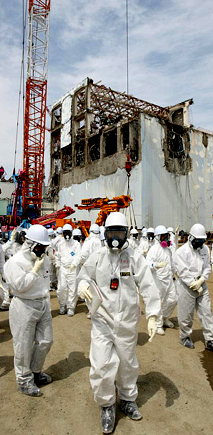New leak at nuclear ground zero
 A new leak has been detected at the Fukushima nuclear power plant.
A new leak has been detected at the Fukushima nuclear power plant.
Highly radioactive water is continuing to gush into the sea years after the 2011 earthquake and tsunami disaster that knocked reactors offline and dealt a big blow to Japan’s nuclear industry.
Tokyo Electric Power Co (TEPCO) says the reading comes from sensors attached to a gutter that pours rain and ground water into a bay near the Fukushima Daiichi plant.
The sensors detected contamination levels up to 70 times higher than those at the plant campus, which itself continues to record extremely high levels.
TEPCO says it has inspected the nearby nuclear waste water storage tanks and did not find any additional abnormalities, but it decided to shut the gutter anyway.
The high reading did fall throughout the day it was discovered, dropping down to about 10 to 20 times more than usual, a company spokesperson said.
“With emergency surveys of the plant and monitoring of other sensors, we have no reason to believe tanks storing radioactive waste water have leaked,” he said.
“We have shut the gutter [from pouring water to the bay]. We are currently monitoring the sensors at the gutter and seeing the trend.”
He said it was unclear what caused the initial spike or the gradual fall in radioactivity.
This incident is just the latest problem plaguing the embattled plant in recent months.
It shows the ongoing difficulty in controlling and decommissioning the plant that saw meltdowns and explosions after a giant tsunami in March 2011.
Fukushima has been called the world's worst nuclear disaster in a generation.
By many experts’ assessments, TEPCO has failed to effectively deal with the masses of contaminated water that has been used to cool the crippled reactors.
There are still molten fuels inside the reactors and streams of groundwater becoming contaminated as it flows through the area.
Despite repeated plans and efforts to help, the potentially-harmful waste water has been flowing into the Pacific Ocean since the meltdown first occurred.
There are now many large storage tanks on the plant's vast campus to try to contain the dangerous leaks.
The International Atomic Energy Agency claims TEPCO has made “significant progress” in cleaning up the plant, but suggests that there might be better ways to discharge treated waste water into the sea.







 Print
Print